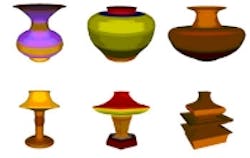Handy-Potter enables users to create 3-D objects with their hands
Researchers at Purdue University (West Lafayette, IN, USA) have developed a design tool that enables people to create virtual 3-D objects with their bare hands by using the Microsoft Kinect camera and advanced software algorithms that interpret hand movements and gestures.
The development of the so-called "Handy-Potter" tool, which was funded by the National Science Foundation, addresses the limitations of conventional computer-aided design tools that are needed to create geometric shapes.
"It allows people to express their ideas rapidly and quickly using hand motions alone," said Karthik Ramani, Purdue University's Donald W. Feddersen Professor of Mechanical Engineering.
For their efforts in developing the tool, Ramani’s researchers won an "all conference best paper" award which was presented during the ASME 2012 International Design Engineering Technical Conferences and Computers and Information in Engineering Conference in Chicago.
A video showing the system in operation is available here while a technical article describing the system in greater detail is available here.
Editor's note: The shapes in the image above were produced with the Handy-Potter tool which was developed at the C Design Lab in Purdue's School of Mechanical Engineering. A patent is pending on the concept.
-- Dave Wilson, Senior Editor, Vision Systems Design
